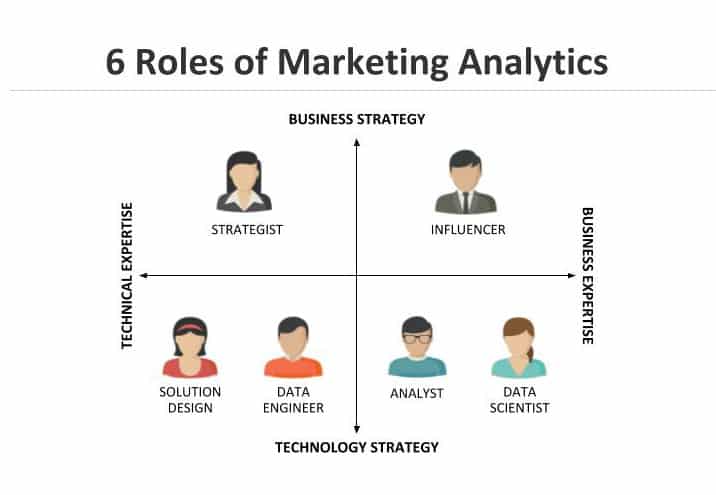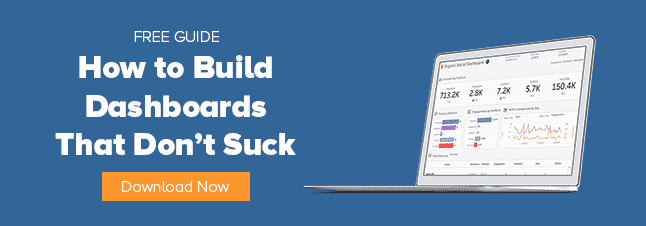
Hate to be that guy, but: Technology by itself isn’t going to bring you success with marketing analytics. You also need the right people in the right roles, supporting your insights and reporting.
In our work with brands and agencies, we’ve identified six key roles that can help you implement an analytics practice and grow it to maturity, so you can leverage cross-channel attribution, media mix modeling and other cool stuff.
By having someone in each role, you can cover both the business and technology demands you’ll face. Some of the marketing analytics roles are more about strategy, while others lean into hands-on expertise.

So what does each role do? How do they help you achieve greater insight into marketing performance?
The Strategist

Everything starts with your strategist. This is someone who is motivated to use data to make decisions about marketing. (Believe it or not, there are people who don’t want to do that. I call them check-writers. All they do is write checks because they don’t really care what happens to their spend.)
The strategist wants to use analytics — and the insights they provide — to drive growth. That growth can come in the form of leads, revenue or however you want to define it.
“Strategist” might not actually be in this person’s title. It could be your director of marketing, your media buyer or some other title. If you have a marketing department, you probably already have a strategist.

The Analyst

The first person you’ll have to go out and hire may be an analyst. This is someone who can help you tell your performance story. On a basic level, they’re building reports for the strategist. More importantly, they should help you notice patterns and insights in the data, too.
Your analyst needs to understand data. It used to be enough to know how to use Excel and build pivot tables, then feed everything into a PowerPoint deck.
But I want you to hear me now: Your analytics strategy can’t be built in Excel and PowerPoint, not when there are so many more powerful tools like Tableau and Power BI available. Your analyst should know their way around a marketing dashboard.
The Data Engineer

The next role is going to be your data engineer. This is someone who allows you to ask more complex questions.
Working alone, it’s pretty easy for an analyst to connect to APIs for Facebook, Twitter, Google Analytics, Google Ads and other sources, then put the data into a marketing dashboard. Boom! You’ve got basic visibility into performance.
As your reporting gets more mature, though, you’re going to need a data engineer to manage those connections. They have an unfortunate tendency to break down and stop collecting data. Your data engineer can also help you connect to data sources that don’t have a user-friendly API or any API at all.
Best of all, the data engineer can configure your data so you can see results for a campaign, a channel, or even a rollup of all your paid media. You want to go beyond showing Facebook data alongside Google Ad data. You want to show total impressions for all your paid social and paid search in a single view. A data engineer can do that.
The Solution Designer

Your solution designer (or solution architect) is one more rung up the evolutionary ladder. They give you the data you need to align marketing and sales.
That way you can see how your marketing spend translates to leads and how (or if) those leads progress through the sales pipeline.
To do that, you need access to your sales, CRM or transaction data, and you need to integrate it with all the media data that your data engineer has set up. It’s a more difficult challenge.
Your solution designer is someone who can think about the long-term scope of your analytics. They’re planning how to build an analytics framework now that can scale to handle greater amounts of data and answer more advanced types of questions later.
BLOG: Learn how to level up your marketing analytics for more advanced insights
The Influencer

For a lot of marketers, the Holy Grail is predictive analytics — modeling out performance before you ever spend a dollar. And that requires a lot of data, usually from multiple teams or departments.
Now I’m sure if you work at a big company, there’s never any internal politics over getting access to other teams’ data. Likewise, if a company uses multiple agencies, they always share data quickly and freely with each other.
[ sips tea quietly ]Your influencer is the change agent, the person who can knock down barriers and get you the data you need.
They’re usually grounded in the business and understand the business strategy. This could be a CFO, CEO, someone who is not part of the analytics space on a day-to-day basis, but who does believe in the value of it.
(The influencer is also pretty important in getting the budget for analytics resources!)
The Data Scientist

Your data scientist is your scuba diver. They’re going deep into the data to find unexpected trends and relationships and bring them to the surface. They can build predictive models. They’re able to apply statistical analysis and machine learning algorithms to your data. They know how to use Python and R.
Ironically, your data scientist is usually the last person to join your team. That’s because you have to have all the other marketing analytics roles in place and doing their jobs in order for the data scientist to be successful.
Don’t hire your data scientist first! Otherwise, they’re going to be stuck doing work that’s supposed to be done by an analyst or data engineer.
The One-Role Rule: The Key to Making the 6 Marketing Analytics Roles Work
If you want your analytics to be successful over the long term, you can only be one of these people. One reason why marketers fail at analytics is because they’re trying to play too many roles.
For smaller teams, there will be times when one person is forced to juggle multiple roles, but they can’t do it indefinitely. That process disintegrates, it’s not scalable, and it lacks focus and depth.
Find your role. Be awesome at it. And then find a way to fill the other roles. It might mean hiring additional staff. It could mean partnering with an outside company to take on some of these jobs — which, full disclosure, is part of Alight’s business model.
Having all six marketing analytics roles is essential to building a practice that’s sustainable and scalable. We’ve found this to be true, over and over, with clients in pretty much any industry you can name.
Our Team Can Be Your Team
Alight’s Analytics-as-a-Service model brings together all the resources you need to produce next-level insights and reporting — including our team of data engineers, solution designers and data scientists. Schedule a call with Alight today!